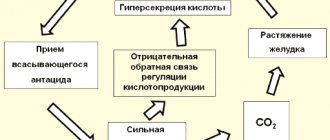Pharmacological properties
The pharmacological activity of the drug is due to the properties of paracetamol, caffeine, phenylephrine hydrochloride and chlorpheniramine maleate, which are part of the drug.
Paracetamol has antipyretic, analgesic and anti-inflammatory effects. The mechanism of action is associated with inhibition of prostaglandin synthesis. Caffeine has a stimulating effect on the central nervous system, mainly on the cerebral cortex, respiratory and vasomotor centers, increases mental and physical performance, reduces drowsiness, fatigue and weakens the effect of central nervous system depressants.
Phenylephrine hydrochloride has a vasoconstrictor effect, reduces swelling of the nasal mucosa and paranasal sinuses.
Chlorphenamine has antihistamine and anticholinergic effects. By blocking H1 receptors, it has an antiallergic effect, reduces the permeability of blood vessels in the mucous membrane of the upper respiratory tract, reduces lacrimation, itching in the eyes and nose.
Contraindications
Hypersensitivity to the components of the drug, other xanthine derivatives (theophylline, theobromine). severe cardiovascular diseases, including conduction disorders, severe atherosclerosis, severe ischemic heart disease. severe dysfunction of the liver and kidneys. congenital hyperbilirubinemia, severe hypertension; prostate adenoma with difficulty urinating; bladder neck obstruction; blood diseases, severe anemia, leukopenia, hyperthyroidism, pyloroduodenal obstruction, diabetes mellitus, asthma, glaucoma, glucose-6-phosphate dehydrogenase deficiency, alcoholism, increased excitability, sleep disturbance, concomitant treatment with MAO inhibitors and for 2 weeks after stopping their use. elderly age.
Special instructions for the use of the drug Flucold tablets and powder for oral use
If the high temperature persists for 3 or more days or occurs again, and the pain does not stop for more than 5 days, it is necessary to reconsider treatment tactics. Use with caution in patients with impaired liver and kidney function, coronary artery disease, diabetes mellitus, and the elderly. During breastfeeding, it is used only if the expected benefit to the mother outweighs the potential risk to the child. When using the drug, you should not drive vehicles or work with potentially dangerous mechanisms.
Side effects
From the skin and subcutaneous tissue: skin rashes, itching, urticaria, erythema multiforme, Stevens-Johnson syndrome, toxic epidermal necrolysis.
From the immune system: hypersensitivity reactions, including anaphylactic shock, angioedema.
Neurological disorders: headache, dizziness, psychomotor agitation and disorientation, anxiety, nervous excitability, fear, irritability, sleep disturbance, insomnia, drowsiness, confusion, hallucinations, depressive states, tremor, tingling and heaviness in the limbs, noise in ears, in some cases - coma, convulsions, dyskinesia, behavioral changes, general weakness.
From the respiratory system: bronchospasm in patients sensitive to acetylsalicylic acid and other NSAIDs.
From the organ of vision: blurred vision and accommodation, mydriasis, increased intraocular pressure, dry eyes.
From the gastrointestinal tract: nausea, vomiting, heartburn, dry mouth, discomfort and pain in the epigastric region, diarrhea, hypersalivation, loss of appetite.
From the hepatobiliary system: impaired liver function, increased activity of liver enzymes, usually without the development of jaundice, hepatonecrosis (when using high doses).
From the endocrine system: hypoglycemia, up to hypoglycemic coma.
From the blood and lymphatic system: anemia, including hemolytic, sulfhemoglobinemia and methemoglobinemia (cyanosis, shortness of breath, heart pain).
From the kidneys and urinary system: nephrotoxicity, interstitial nephritis, papillary necrosis, urinary disorders, dysuria, urinary retention.
From the cardiovascular system: hypertension, tachycardia or reflex bradycardia, arrhythmia, shortness of breath, heart pain.
Overdose of the drug Flukold tablets and powder for oral use, symptoms and treatment
Symptoms of paracetamol overdose: pale skin, nausea, vomiting, anorexia, abdominal pain, later (after 12–48 hours) signs of liver damage appear. Acute liver failure and acute renal failure may develop due to acute tubular necrosis. Arrhythmia may develop. An overdose of phenylephrine may be accompanied by headache, increased blood pressure, heart rhythm disturbances, nausea and vomiting. Treatment: gastric lavage, intake of activated carbon, symptomatic treatment, administration of methionine and acetylcysteine as antidotes to paracetamol.
special instructions
Do not exceed the indicated dose.
Avoid simultaneous use with other drugs intended for the symptomatic treatment of colds and flu, drugs containing paracetamol. This medicine is not recommended for use simultaneously with sedatives, hypnotics or drinks containing alcohol.
The doctor prescribes the drug only after assessing the risk/benefit ratio in the following cases: hypertension; epilepsy; prostate adenoma; heart rhythm disturbances; pheochromocytoma; urinary disorders. If, on the recommendation of a doctor, the drug is used for a long period, it is necessary to monitor the functional state of the liver and the picture of peripheral blood.
When using the drug, you should avoid excessive consumption of coffee, strong tea, other tonic drinks and medications containing caffeine. This can cause problems sleeping, tremors, tension, irritability, and increased heart rate.
Use during pregnancy and lactation. Contraindicated.
The ability to influence reaction speed when driving vehicles or working with other mechanisms. During the treatment period, you should avoid driving vehicles, operating machinery and other hazardous activities.
Children. The drug is used to treat children over 12 years of age.
Use of the drug Flukold tablets and powder for oral use
Adults and children over 12 years of age are prescribed 1 tablet 3-4 times a day, but no more than 5 tablets per day. Children aged 6–12 years: tablets 3–4 times a day. The course of treatment should not exceed 7 days. When using the powder, adults and adolescents over 12 years of age are prescribed the contents of one sachet of the drug up to 4 times a day. The interval between doses should be at least 4 hours. The maximum daily dose is 4 sachets. The contents of the sachet are dissolved in 1 glass of water before use. The duration of treatment is no more than 3 days.
Interactions
The rate of absorption of paracetamol may increase when used with metoclopramide and domperidone and decrease when used with cholestyramine. with simultaneous long-term use, the anticoagulant effect of coumarins (for example warfarin) increases. Barbiturates reduce the severity of the antipyretic effect of paracetamol. anticonvulsants (phenytoin, barbiturates, carbamazepine), which stimulate microsomal liver enzymes, and isoniazid may increase the hepatotoxicity of paracetamol. paracetamol reduces the effectiveness of diuretics.
The interaction of phenylephrine hydrochloride with MAO inhibitors causes a hypertensive effect, with tricyclic antidepressants (amitriptyline) - increases the risk of cardiovascular side effects, with digoxin and cardiac glycosides - leads to arrhythmias and heart attack. Phenylephrine with other sympathomimetics increases the risk of adverse cardiovascular reactions and may reduce the effectiveness of beta-adrenergic receptor blockers and other antihypertensive drugs (reserpine, methyldopa) with an increased risk of hypertension and adverse cardiovascular reactions.
The severity of the inhibitory effect of chlorpheniramine maleate can be significantly increased by the simultaneous use of the drug with hypnotics, barbiturates, sedatives, neuroleptics, tranquilizers, anesthetics, narcotic analgesics, and alcohol. Chlorphenamine enhances the anticholinergic effect of atropine, antispasmodics, tricyclic antidepressants, and antiparkinsonian drugs.
Caffeine enhances the effect (improves bioavailability) of analgesics-antipyretics, potentiates the effects of xanthine derivatives, α- and β-adrenergic agonists, and psychostimulants.
Cimetidine, hormonal contraceptives, isoniazid enhance the effect of caffeine.
Caffeine reduces the effect of opioid analgesics, anxiolytics, hypnotics and sedatives, is an antagonist of anesthetics and other drugs that depress the central nervous system, and a competitive antagonist of adenosine and ATP drugs. With the simultaneous use of caffeine with ergotamine, the absorption of ergotamine in the gastrointestinal tract improves, and with thyroid-stimulating drugs, the thyroid effect increases. Caffeine reduces the concentration of lithium in the blood.
Interactions of the drug Flukold tablets and powder for oral use
It is not recommended to use Flukold simultaneously with other drugs for the symptomatic treatment of colds, vasoconstrictors for the treatment of rhinitis and with drugs containing paracetamol. The effect of paracetamol is enhanced when combined with codeine, ascorbic acid, scopolamine, chlorphenamine, propyphenazone and caffeine. With the simultaneous use of barbiturates, tricyclic antidepressants, and alcohol, the half-life of paracetamol may increase. Long-term use of anticonvulsants may reduce the effectiveness of paracetamol.
Overdose
In case of an overdose of paracetamol, pale skin, nausea, vomiting, anorexia and abdominal pain are noted in the first 24 hours. When taking high doses, disorientation, agitation, dizziness, sleep disturbances, heart rhythm disturbances and pancreatitis may occur. in rare cases, acute renal failure with tubular necrosis has been reported, which is manifested by pain in the lumbar region, hematuria, proteinuria; nephrotoxicity (renal colic, interstitial nephritis).
Taking 10 g or more of paracetamol by adults, especially concomitantly with alcohol, and by children taking more than 150 mg of paracetamol per kg of body weight can lead to hepatocellular necrosis with the development of encephalopathy, hepatic coma and death. The first clinical signs of hepatonecrosis may appear 12–48 hours after an overdose. Impaired glucose metabolism and metabolic acidosis may occur. With long-term use of high doses, aplastic anemia, pancytopenia, agranulocytosis, neutropenia, leukopenia, thrombocytopenia are possible.
An overdose of phenylephrine hydrochloride causes hyperhidrosis, psychomotor agitation or depression of the central nervous system, headache, dizziness, drowsiness, impaired consciousness, arrhythmias, tremor, hyperreflexia, convulsions, nausea, vomiting, irritability, anxiety, hypertension.
In case of an overdose of chlorpheniramine maleate, atropine-like symptoms are possible: mydriasis, photophobia, dry skin and mucous membranes, increased body temperature, intestinal atony. Depression of the central nervous system, which is accompanied by respiratory disorders and disturbances in the functioning of the cardiovascular system (decreased heart rate, decreased blood pressure up to vascular insufficiency).
High doses of caffeine can cause pain in the epigastric region, vomiting, rapid diuresis, rapid breathing, extrasystole, tachycardia or cardiac arrhythmia, effects on the central nervous system (dizziness, insomnia, nervous agitation, irritability, state of passion, anxiety, tremor, convulsions).
Treatment: During the first 6 hours after a suspected overdose, it is necessary to perform gastric lavage followed by hospitalization of the patient.
During the first 8 hours after an overdose, use oral methionine or administer cysteamine or N-acetylcysteine; symptomatic therapy; for severe hypertension - use of α-, β-adrenergic receptor blockers.
Side effects of the drug Flukold tablets and powder for oral use
As a rule, the drug is well tolerated. The side effects of paracetamol are usually mild. Possible allergic reactions, skin itching, rash, dyspeptic symptoms, leukopenia, neutropenia, thrombocytopenia, agranulocytosis, pancytopenia. Phenylephrine hydrochloride can cause increased blood pressure, headache, and vomiting. Tachycardia and reflex bradycardia are rarely possible. Side effects associated with caffeine include gastrointestinal irritation and central nervous system stimulation. Side effects of phenylpropanolamine are nausea, vomiting, abdominal pain.
Note!
Description of the drug Flukold-N table. No. 200 on this page is a simplified author’s version of the apteka911 website, created on the basis of the instructions for use.
Before purchasing or using the drug, you should consult your doctor and read the manufacturer's original instructions (attached to each package of the drug). Information about the drug is provided for informational purposes only and should not be used as a guide to self-medication. Only a doctor can decide to prescribe the drug, as well as determine the dose and methods of its use.


